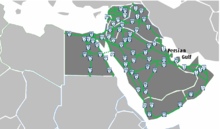This is an old revision of this page, as edited by Citation bot (talk | contribs) at 23:54, 19 May 2020 (Add: encyclopedia. Removed parameters. Some additions/deletions were actually parameter name changes. | You can use this bot yourself. Report bugs here. | Activated by Amigao | Category:Regions of Asia | via #UCB_Category). The present address (URL) is a permanent link to this revision, which may differ significantly from the current revision.
Revision as of 23:54, 19 May 2020 by Citation bot (talk | contribs) (Add: encyclopedia. Removed parameters. Some additions/deletions were actually parameter name changes. | You can use this bot yourself. Report bugs here. | Activated by Amigao | Category:Regions of Asia | via #UCB_Category)(diff) ← Previous revision | Latest revision (diff) | Newer revision → (diff) An accepted version of this page, accepted on 19 May 2020, was based on this revision."Mashreq" redirects here. For the bank, see Mashreq (bank). This article is about a geographical region. For other uses, see Mashriq (disambiguation). The Eastern part of the Arab world
| Mashriq Error: {{Lang}}: invalid parameter: |link= (help) | |
|---|---|
 | |
| Countries and territories | |

The Mashriq (Template:Lang-ar), sometimes spelled Mashreq or Mashrek, is the eastern part of the Arab world, located in Western Asia and eastern North Africa. This comprises of the Arab states of Bahrain, Egypt, Iraq, Jordan, Kuwait, Lebanon, Oman, Palestine, Qatar, Saudi Arabia, Sudan, Syria, the United Arab Emirates and Yemen. Poetically, the "Place of Sunrise", the name is derived from the verb sharaqa (Template:Lang-ar "to shine, illuminate, radiate" and "to rise"), referring to the east, where the Sun rises.
Geography
As the word Mashriq refers to countries bounded between the Mediterranean Sea and Iran, it is the companion term to Maghreb (Template:Lang-ar), the western part of North Africa. Libya may itself be seen as bifurcated between Mashriq and Maghreb influences, with its eastern part (Cyrenaica) seen as linked more to Egypt and the Mashriq.
These geographical terms date from the early Islamic expansion. This region is similar to the Bilad al-Sham and Mesopotamian regions combined. As of 2014, the Mashriq is home to 1.7% of the global population.
Cooperation

All of the countries located in the Arab Mashreq area are members of the Arab League (although Syria's membership is currently suspended), the Greater Arab Free Trade Area, and the United Nations. The region cooperates in several projects including the Arab Mashreq International Road Network and the Arab Mashreq International Railway. Several nations are also members in the GCC and others have tried unity before, such as United Arab Republic in the 60's and 70's.
See also
- Arabian Peninsula
- Cradle of civilization
- Fertile Crescent
- Levant
- Maghreb, "Place of Sunset", which contrasts Mashriq, "Place of Sunrise"
- Nile
- Shaam (Greater Syria)
References
- "About ANPGR". Arab Network of Plant Genetic Resources.
- "Mashreq". Association of Agricultural Research Institutions in the Near East & North Africa. Archived from the original on 2017-02-24. Retrieved 2016-05-02.
- "Archived copy". Archived from the original on March 4, 2016. Retrieved August 19, 2015.
{{cite web}}: CS1 maint: archived copy as title (link) - "لماذا يستثنى الأردن من التقسيم؟ الوضع الداخلي هو العنصر الحاسم*فهد الخيطان" [Why is Jordan exempted from the division? The internal situation is a critical component * Fahd strings]. rasseen.com (in Arabic). Rasseen. 2014-07-13.
- bank, world. "Economic interrogation in the mashriq" (PDF). siteresources.
- "Mashriq GEOGRAPHICAL REGION, MIDDLE EAST". Retrieved 12 March 2018.
{{cite web}}: Unknown parameter|encyclopedia=ignored (help) - "European Neighbourhood Policy in the Mashreq Countries: Enhancing Prospects for Reform". Centre for European Policy Studies. 2005-09-01. Archived from the original on 2014-02-01. Retrieved 2014-01-17.
- Introduction to Migration and the Mashreq Archived February 3, 2014, at the Wayback Machine
- "Migrants from the Maghreb and Mashreq Countries" (PDF). IOM International Organization for Migration. July 2002. Archived from the original (PDF) on 2014-02-02. Retrieved 2014-01-19.
- Alvarez, Lourdes María (2009). Abu Al-Ḥasan Al-Shushtarī. Paulist Press. p. 157. ISBN 978-0-8091-0582-3.
- Peek, Philip M.; Yankah, Kwesi (2003-12-12). African Folklore: An Encyclopedia. Routledge. p. 442. ISBN 978-1-135-94873-3.
- Gall, Michel Le; Perkins, Kenneth (2010). The Maghrib in Question: Essays in History and Historiography. University of Texas Press. p. 8. ISBN 978-0-292-78838-1.
- Clancy-Smith, Julia (2013-11-05). North Africa, Islam and the Mediterranean World. Routledge. p. 98. ISBN 978-1-135-31213-8.
- Official estimate of the Population of Egypt Archived May 25, 2013, at the Wayback Machine
- UN estimate for Lebanon
- Official Jordanian population clock Archived January 17, 2012, at the Wayback Machine
- "National Main Statistical Indicators". State of Palestine – Palestinian Central Bureau of Statistics. Archived from the original on 2016-12-03. Retrieved 2016-05-02.
- UN estimate for Syria
- "Iraq". The World Bank.
This Middle East location article is a stub. You can help Misplaced Pages by expanding it. |